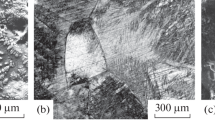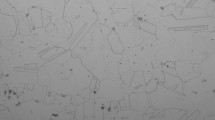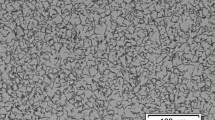Abstract
Until recently, the main way to increase the high-temperature strength of dispersion-hardening alloys consisted in changing the content of the alloying elements in order to determine their optimum concentrations that would ensure specified sets of properties. As a result, modern industrial high-temperature nickel alloys contain 10 to 15 alloying and microalloying elements and the solubility of components in the reinforcing phases is maximum. However, this has not solved completely the problem of creep resistance and fracture of high-temperature materials, because the typical fracture in polycrystalline castings occurs along grain boundaries perpendicular to the axis of load application. The present work is concerned with the structure and properties of single-crystal high-temperature nickel alloys under cyclic loading.
Similar content being viewed by others
References
B. E. Paton, G. B. Stroganov, S. T. Kishkin, et. al,High-Temperature Strength of Castable Nickel Alloys and Their Protection from Oxidation [in Russian], Naukova Dumka, Kiev (1987).
Superalloy II. High-Temperature Materials for Aerospace and Industrial Power, Wiley-Interscience, New York - Toronto - Chichester - Brisbane - Singapore (1986).
Demande De Brevet D'Invention Fr. No. 2578554, Int. Cl4 C 22 C 19 / 05, C 22 F 1 / 10, March 5 (1985).
K. Matsugi, R. Yokoyama, and Y. Murata, “High-temperature properties of single-crystal superalloys optimized by an electronic theory,” in:High Temperature Materials for Power Engineering 1990, Proc. of Conf in Liege, Belgium, 24–27 Sept. 1990, Part II, Kluwer Academic Publishers, Dordrecht - Boston -London (1990), pp. 1251–1260.
D. J. Fraiser, J. R. Whetstone, K. Harris, et al., “Process and alloy optimization for CMSX-4 superalloy single crystal airfoils,” in:High Temperature Materials for Power Engineering 1990, Proc. of Conf in Liege, Belgium, 24–27 Sept. 1990, Part II, Kluwer Academic Publishers, Dordrecht - Boston - London (1990), pp. 1281–1300.
T. Ohno, R. Watanabe, and T. Tanaka, “Development of a nickel-base single-crystal superalloy containing molybdenum by an alloy designing method,”J Iron Steel Inst. Jpn.,74(11, 133–140 (1988).
Patent No. 2184456 A. Int. Cl4 C 22 C 19 / 05, June 24, 1987.
R. A. Dul'nev, “Strength models under low-cycle fatigue,” Probl. Prochnosti, No. 4, 8–13 (1989).
B. A. Lerch and S. D. Antolovich, “Fatigue crack propagation behavior of a single-crystal superalloy,”Met. Trans,21A(8), 2169–2177 (1990).
J. S. Compton and J. W. Martin, “Crack growth in a single-crystal superalloy at elevated temperatures,”Met. Trans.,15A(9), 1711–1718 (1984).
Author information
Authors and Affiliations
Additional information
Translated from Metallovedenie i Termicheskaya Obrabotka Metallov, No. 6, pp. 2–5, June, 1995.
Rights and permissions
About this article
Cite this article
Petrushin, N.V., Sorokina, L.P. & Zhukov, S.N. Structural features of deformation and fracture of single-crystal high-temperature nickel alloys under cyclic loading. Met Sci Heat Treat 37, 217–221 (1995). https://doi.org/10.1007/BF01152221
Issue Date:
DOI: https://doi.org/10.1007/BF01152221




